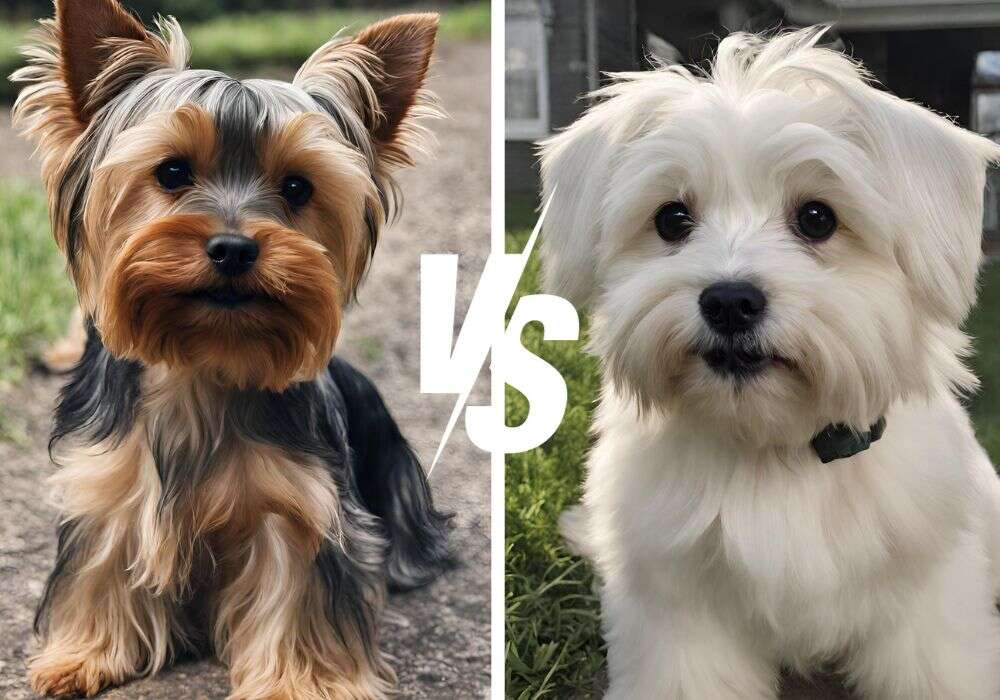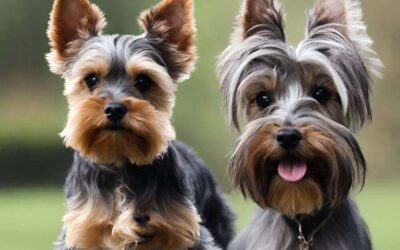Introduction
The Yorkshire Terrier and the Havanese are two popular small dog breeds that are often compared to each other. Both breeds are known for their friendly, affectionate temperaments and their hypoallergenic coats. However, there are some key differences between the two breeds that potential owners should be aware of before making a decision.
In this article, we will compare the Yorkshire Terrier and the Havanese in terms of their size, energy level, grooming requirements, and temperament. We will also discuss the pros and cons of each breed so that you can make an informed decision about which one is the right fit for your family.
Key Takeaways
| Aspect | Yorkie | Havanese |
|---|---|---|
| Size | ||
| Temperament | ||
| Exercise Needs | ||
| Coat Type | ||
| Grooming Needs | ||
| Lifespan | ||
| Shedding | ||
| Health Concerns | ||
| Training Difficulty | ||
| Popularity (AKC Ranking) |
History of Yorkies
- Origin: The Yorkshire Terrier originated in Yorkshire, England, in the 19th century.
- Purpose: Originally bred as ratcatchers, Yorkies are now popular companion dogs.
- History: The first Yorkies were bred by crossing the Scottish Terrier with the Manchester Terrier.
- Popularity: Yorkies are one of the most popular dog breeds in the United States.
History of Havanese
Origins: The Havanese is a Cuban dog breed that is believed to have originated from the Bichon Tenerife, a small white dog that was brought to Cuba by Spanish explorers in the 16th century. The Havanese was originally bred as a companion dog for the upper class in Cuba, and it quickly became a popular pet among the wealthy and famous.
History in Cuba: The Havanese was a popular pet among the upper class in Cuba until the Cuban Revolution in 1959. During the revolution, many Havanese were killed or abandoned, and the breed nearly went extinct. However, a few Havanese were smuggled out of Cuba and brought to the United States, where they were bred with other Bichon breeds to create the modern Havanese.
History in the United States: The Havanese was first recognized by the American Kennel Club (AKC) in 1996, and it has since become a popular pet in the United States. The Havanese is known for its friendly personality, its hypoallergenic coat, and its small size, making it a good choice for families with children or people who live in apartments.
Appearance of Yorkies
Yorkies are small, sturdy dogs with long, silky hair. They have a distinctive head shape with a flat forehead, a long muzzle, and a dark brown nose. Their eyes are dark brown and almond-shaped, and their ears are small and V-shaped.
Yorkies come in a variety of colors, including black, brown, blue, and tan. They typically weigh between 4 and 7 pounds and stand 8 to 10 inches tall at the shoulder.
Yorkies are a high-maintenance breed when it comes to grooming. Their long hair requires daily brushing and regular trimming. They also need to be bathed regularly to keep their coats clean and healthy.
Yorkies may be little, but they’re a hardy and robust breed. Between 12 and 15 years is their average lifespan.
Appearance of Havanese
The Havanese is a small, fluffy dog with a long, silky coat. They are typically white, cream, or apricot in color, but can also be black, brown, or gray. Their coats are low-maintenance and only require brushing once or twice a week.
Havanese have big, round eyes that are usually dark brown or black. Their ears are also large and round, and they are set high on their head. Havanese have a short muzzle and a small, upturned nose.
Their bodies are compact and well-proportioned. They have a long tail that they carry curled over their back. Havanese weigh between 8 and 13 pounds and stand 8 to 11 inches tall at the shoulder.
Temperament of Yorkies
Yorkies have a reputation for being full of energy and fun. They have a strong sense of family and are devoted to their loved ones. However, without sufficient socialization, they might be timid towards strangers and noisy barkers.
Key points:
- Yorkies are feisty and playful
- They are loyal and affectionate towards their family members
- They can be wary of strangers
- They may bark excessively if they are not properly socialized
Temperament of Havanese
Havanese are known for being friendly, affectionate, and playful dogs. They are also very intelligent and eager to please, making them easy to train. Havanese are good with children and other pets, and they make excellent family pets.
However, Havanese can also be a bit of a handful. They are known for being barky, and they can be destructive if they are not properly exercised and stimulated. Havanese also need a lot of attention, and they may not be the best choice for people who are not home often.
Overall, Havanese are wonderful dogs that make great companions. However, it is important to be aware of their potential drawbacks before bringing one home.
Health of Yorkies
Yorkies are generally healthy dogs, but they can be prone to certain health conditions, including:
- Hypoglycemia: This is a condition in which the blood sugar levels become too low. It can be caused by a number of factors, including not eating enough, eating too quickly, or being too active. Symptoms of hypoglycemia include weakness, trembling, seizures, and coma.
- Patellar luxation: This is a condition in which the kneecap slips out of place. It can be caused by genetics, trauma, or obesity. Symptoms of patellar luxation include lameness, difficulty walking, and pain.
- Legg-Calve-Perthes disease: This is a condition in which the blood supply to the hip joint is cut off, causing the bone to die. It is most common in young Yorkies. Symptoms of Legg-Calve-Perthes disease include lameness, pain, and swelling in the hip joint.
- Tracheal collapse: This is a condition in which the trachea, or windpipe, becomes narrowed. It can be caused by genetics, obesity, or chronic coughing. Symptoms of tracheal collapse include a honking cough, difficulty breathing, and exercise intolerance.
- Dental problems: Yorkies are prone to dental problems, such as tartar buildup, periodontal disease, and fractured teeth. It is important to brush your Yorkie’s teeth regularly and take them to the vet for dental checkups.
Health of Havanese
The Havanese is a generally healthy breed, but there are some health conditions that they are more prone to than other breeds. These include:
• Hip dysplasia: This is a condition in which the hip joint does not develop properly, leading to pain and arthritis.
• Patellar luxation: This is a condition in which the patella (kneecap) slips out of place.
• Eye problems: Havanese can be prone to a variety of eye problems, including cataracts, glaucoma, and corneal dystrophy.
• Heart problems: Havanese can be prone to a variety of heart problems, including arrhythmias, valve problems, and cardiomyopathy.
• Skin problems: Havanese can be prone to a variety of skin problems, including allergies, hot spots, and sebaceous adenitis.
It is important to take your Havanese to the vet for regular checkups so that any health problems can be caught early and treated.
Final Thoughts
Understanding the differences between Yorkies and Havanese is key for any potential dog owner. This includes acknowledging their distinct grooming needs, where a suitable brush for yorkies and Havanese is indispensable. Appropriate yorkie dog clothes are also necessary to keep your Yorkie cozy. Additionally, familiarizing yourself with the different yorkie health problems and those that may affect Havanese is crucial for providing the best care for your pet.
FAQs: Yorkie vs Havanese
Which breed is more suitable for apartment living?
Both the Yorkie and Havanese are well-suited for apartment living due to their small size and moderate exercise needs. They are adaptable and can comfortably live in limited spaces as long as they get their daily dose of play and walks.
How often do these breeds need grooming?
Yorkies, with their long and silky coats, require regular grooming to prevent matting and tangles. Havanese, with their soft and wavy coats, also need frequent grooming, but it might be slightly less intensive than the Yorkie’s regimen. Regular brushing and occasional trims are essential for both breeds.
Are they good with children and other pets?
Both breeds can be good with children and other pets, especially if they are socialized from a young age. Havanese tend to be more consistently friendly and tolerant, while Yorkies can sometimes be more assertive or territorial.
How easy are they to train?
Yorkies can be moderately challenging to train due to their independent nature, while Havanese, being eager to please, might be slightly easier. However, with patience and consistent training methods, both breeds can be well-behaved companions.
Are there any common health concerns to be aware of?
Both breeds have their health concerns. Yorkies can be prone to dental issues, luxating patella, and liver shunt, among others. Havanese may face challenges with hip dysplasia, cataracts, and patellar luxation. Regular check-ups and being aware of breed-specific issues can help in early detection and management.

As a lifelong dog lover, I fell in love with Yorkies for their spunky personalities, intelligence, and unwavering loyalty.
As a dedicated Yorkie owner, I have spent years learning about the breed and how to provide the best possible care for them. From finding the proper diet to exercise, and so much more! I take every aspect of my Yorkie’s life seriously.
In addition to being a loving dog parent, I’m an avid blogger, sharing my experiences and insights on all things Yorkie-related. From training tips to grooming advice, Yorkieclothing.com is a go-to resource for other Yorkie owners worldwide.




